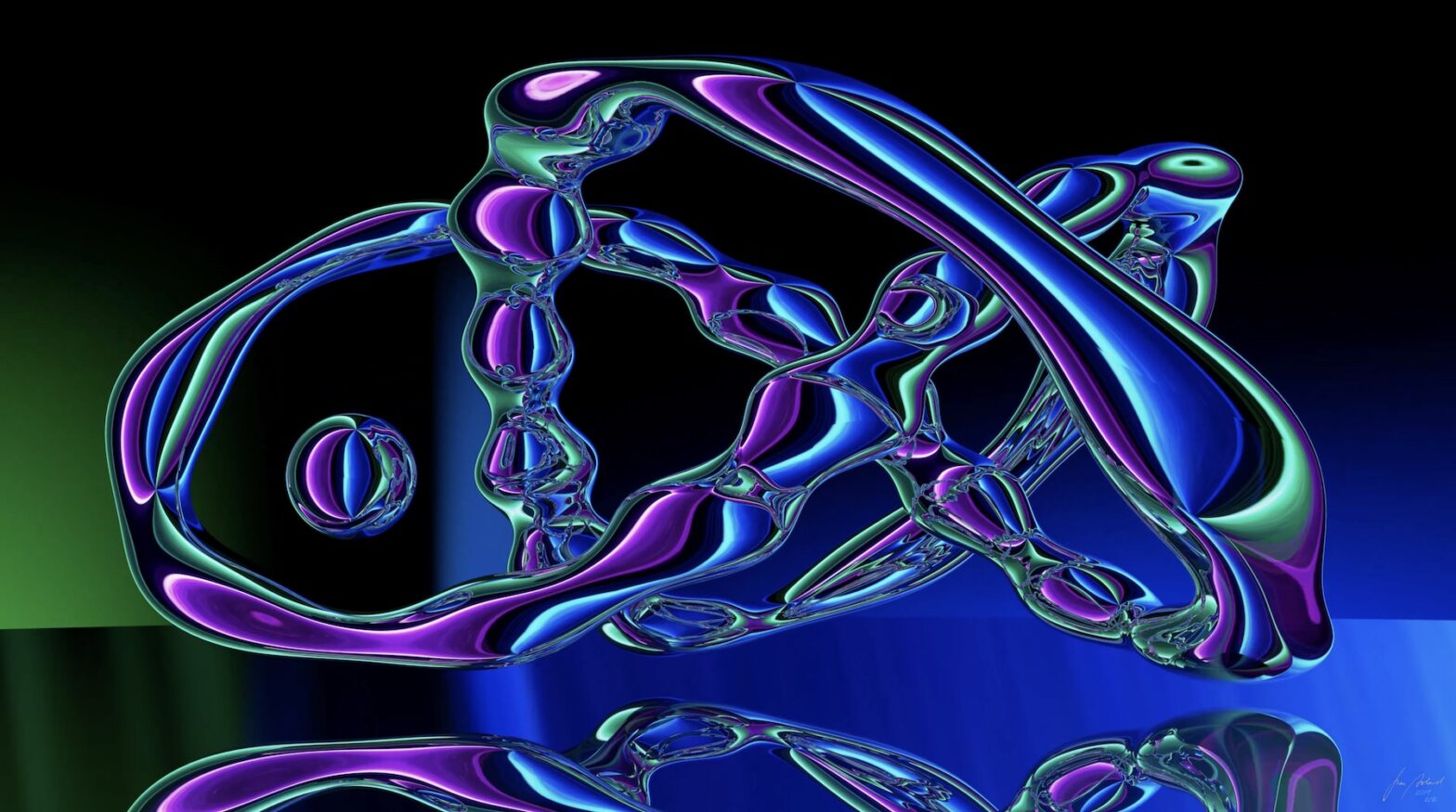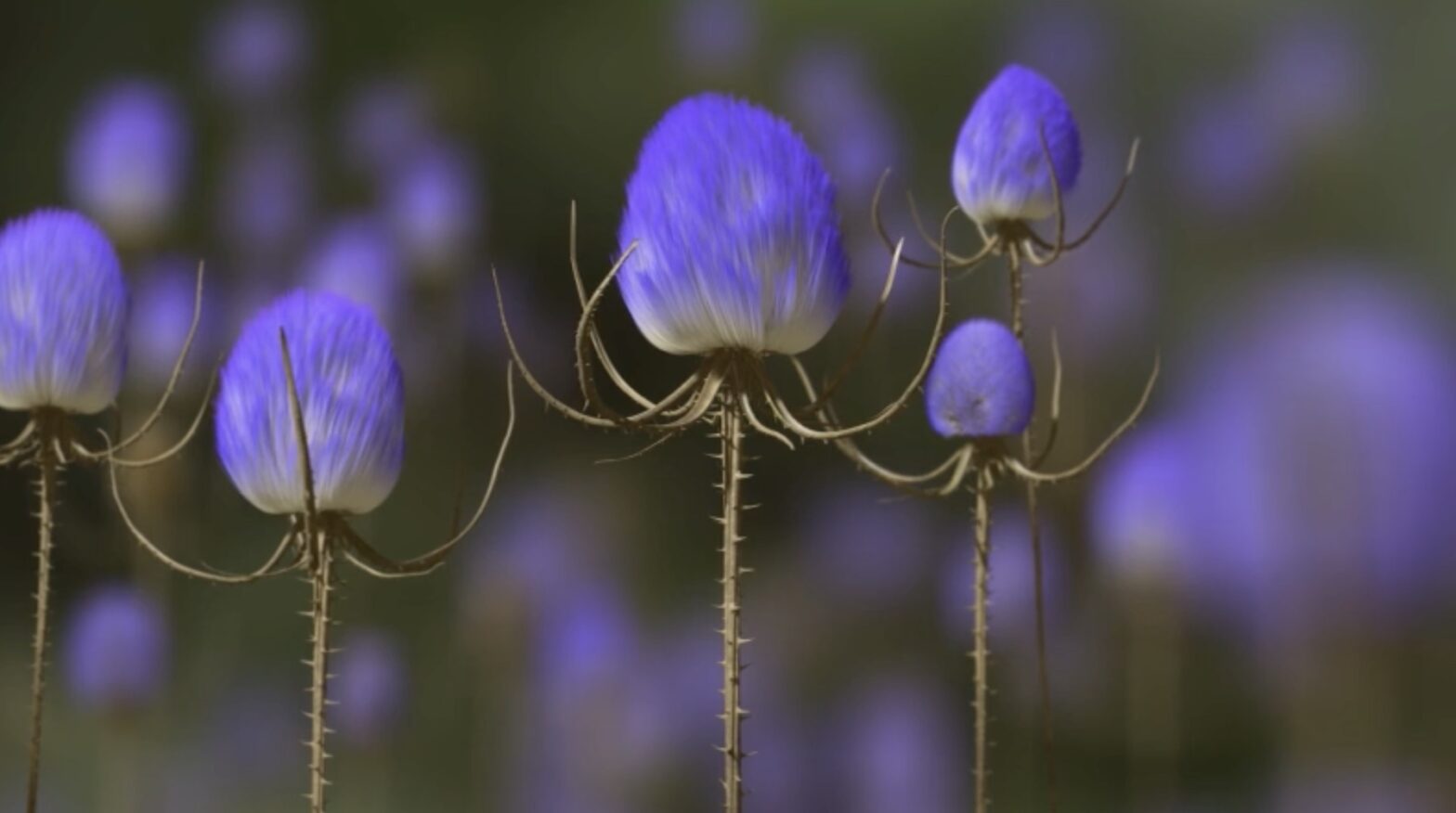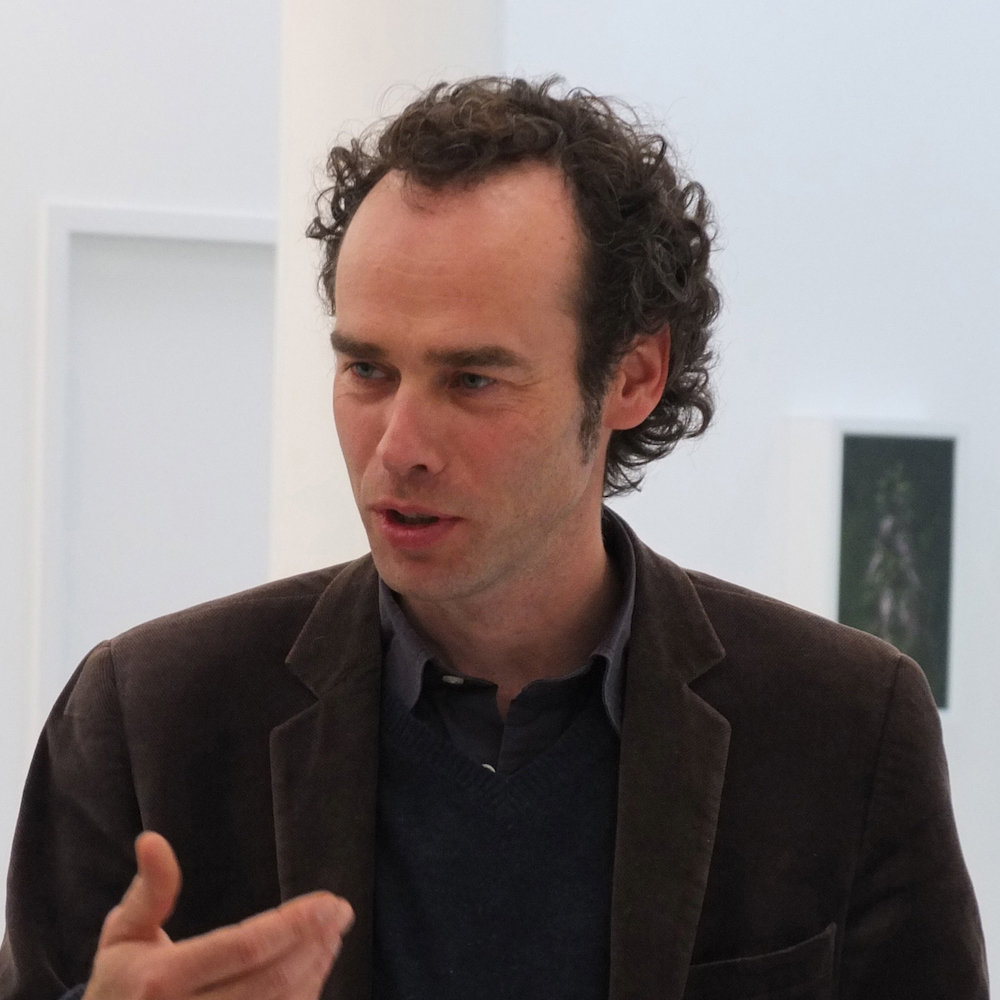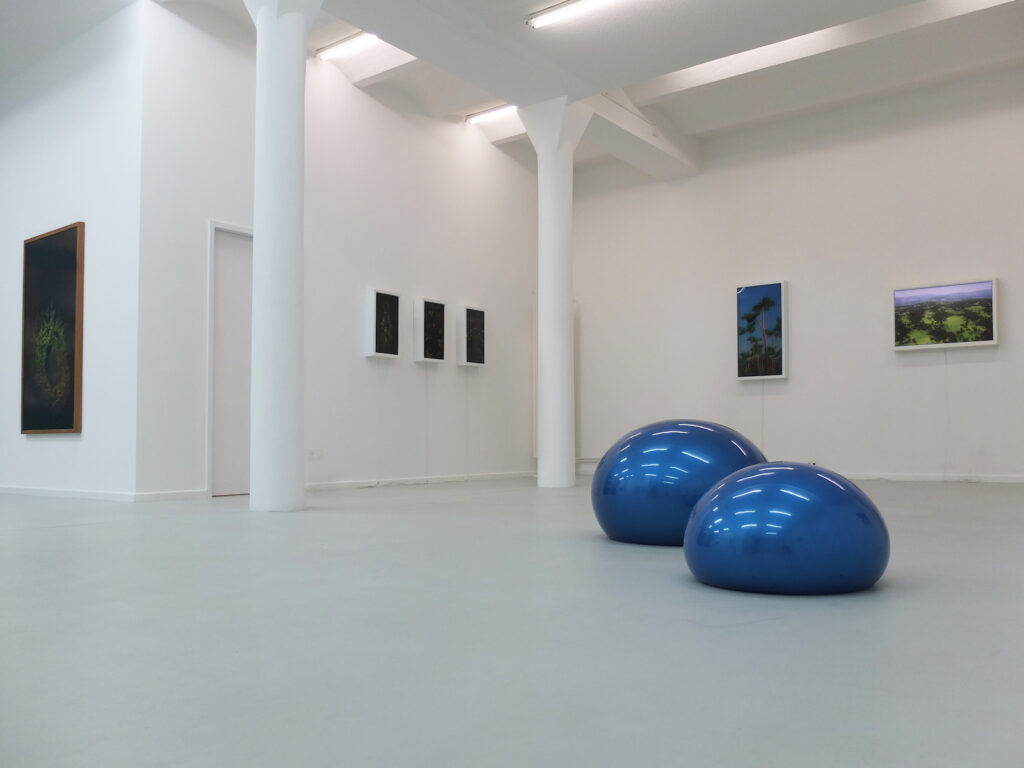NIIO Editorial

Stan Adard, a graduate in social psychology and an educator, has long recognized the significance of breath in stress reduction. This insight, combined with years of meditation experience, has been a guiding force in Adard’s career, spanning over three decades as the owner and CEO of various IT companies. Adard’s passion lies at the intersection of humanity and technology, a fascination tracing back to the early days of computer innovation. Committed to exploring the use of art as a mindfulness tool, Adard employs a unique 4-dimensional digital brush, where time represents the fourth dimension, infusing his pictures and experimental art films with a palpable sense of breath and flow.
Practice conscious breathing with Stan Adard’s Breathing Pictures.
Stan Adard. The Breathing Pictures: Sky Dance, 2017
As a professional of the software industry and social psychologist, what is your opinion on the way digital media influence our mental health?
To form an opinion, I need data and details. Digital media is an extremely broad term, and I don’t want to join those who mainly lament the dark side of new media. From the YouTube help videos created by hundreds of creators with loving intent to news and social media networks where digital content often creates a breathless atmosphere. In addition to these, just as examples of the many layers in the digital media landscape, there’s the entire digital advertising world that inundates us from practically every device. Or digital art, which can either unsettle, bore, or inspire us.
We experience daily the challenges of not simply being swept away by this flood of possibilities. Where do we direct our attention? It’s our decision which aspects of digital media empower us and which weaken us. This process of realization is not always easy, as we often don’t immediately sense whether something is beneficial or weakens us in the long run. The world is becoming more complex and is already overwhelming us in many aspects. That’s why it’s important to find an inner path, an inner anchor. Conscious breathing is a crucial key to this. And if I can do this in the form of digital breath images, it helps in using digital media productively.
“A single image cannot lead a viewer to Nirvana. But it reminds us that it’s time to consider what conscious breathing can achieve at its core.”
You have stated that fear and anxiety are often consciously used to manipulate people. Could your work be seen, thus, as being not only about mindfulness but also social change?
You’ve caught me there. I see how our world is trapped in a system based on fear. As a system architect for over three decades, I have an eye for systems. And the overall system that towers over the national and alliance subsystems of the entire world serves only one purpose: to channel the profits from this planet’s resources and the labor of every inhabitant upwards. Into the hands of a few. This happens with a ruthlessness that sends shivers down my spine. The hunger in the world, the senseless wars, the acts of terror in the name of some selfinvented, vengeful god. The fuel is fear. In my view, fear is the opposite of love. Hatred stems from fear. What I can do in my smallness against this machinery is to bring to light that conscious breathing helps us so that our thoughts, and therefore our fears, can no longer control us. It’s an illusion to think that we can control our thoughts. But we can learn not to be controlled by our thoughts anymore. The breathing images, in their simplicity, are a subversive and loving element against a system that needs to be fundamentally renewed. Of course, a single image cannot lead a viewer to Nirvana. But it daily reminds us that it’s time to consider what conscious breathing can achieve at its core.
Stan Adard. The Breathing Pictures: Breathing Luxury, 2017
Let’s talk about the artworks we are now showcasing on Niio. Can you elaborate on the differences between the breathing pictures and the flowing pictures?
Most of my breathing pictures come to life during a process where I create my next breathing film. My digital experimental films must flow and breathe. Sometimes, an endlessly flowing motion arises from the film’s context, into which I then, at times, insert a breathing structure or infuse the structure itself with a breathing motion. ‘Eternal Blue’ is such an example. The viewer needs to take a moment to tune into the image until they discover the breathing motion.
In terms of their appearance, these artworks are often characterized by the presence of shiny, reflective objects and neon colors. Is this a personal aesthetic decision or does it respond to meditation purposes?
The ‘neon colors’ are generated by a graphics card in my server. In 2019, I was invited to create a breathing picture for an eSports gaming event in Asia (over Niio). To visually capture the attention of the mostly young participants, I used colors they are well acquainted with from their gaming servers.
Using the same colors, I then created a small series of pictures. However, in general, I choose colors based on aesthetic aspects. Colors have to appeal to me so that I can spend a month working with them, which is the average time it takes to create a new image. As an educated social psychologist, I am well aware of colors and their perception, but I rely on my intuition and often chance to choose the colors.
“Each ‘breathing picture’ exists only once as an original, marked with the appropriate signature, and is registered in the blockchain as proof of existence.”
Your signature is present in the lower right corner of each artwork. Does this mean that you conceive them as a painting? Is it to reinforce their perception as a work of art?
Exactly! A decade ago, my goal was to bridge the gap between classical paintings and digital art. In this vision, digital works would reveal their true, breathing form only when the viewer stands calmly in front of the artwork, allowing them to perceive the subtle breathing movements.
Right from the beginning, the signature, along with the year and edition, was a crucial means in the digital realm of art to precisely locate a work. Each ‘breathing picture’ exists only once as an original, marked with the appropriate signature, and is registered in the blockchain as proof of existence. The same applies to unique NFTs. For streaming platforms, exhibitions, and fairs, I always use an Artist Copy to ensure the integrity of the original work.
Stan Adard. The Breathing Pictures: Clematis Torus, 2018
Usually, a sphere is the element that guides the meditation. Does it have a different purpose according to its movement in the composition? Would you say that certain movements are easier to carry out a guided breathing exercise?
A sphere is a perfect geometric form. Inhaling enlarges the sphere and makes it rise, just like our chest does. Exhaling lowers the focal object and makes it smaller again.
Over the years, I’ve realized that in public spaces, the breathing movement must be clearly visible. People are often in a rush, and if we want to motivate them for a single conscious breath, it needs to be evident that something is breathing. The representation of breath can take many forms, and for each image, I explore the possibilities for it to fulfill its purpose in either a calm setting (gallery, living space) or a more hectic place (art fairs, exhibitions, Times Square).
“People are often in a rush, and if we want to motivate them for a single conscious breath, it needs to be evident that something is breathing.”
Tell me about the use of the torus as a recurring shape in your compositions. What do you find most interesting and/or effective in terms of guiding the viewer’s attention in this shape?
A torus symbolizes infinity for me. I also enjoy twisting a torus, forming a lemniscate, or adding gentle extensions to it. The eye can then glide along the structures of this ever-circular body, capturing the details. Ultimately, we reach a point where we perceive the structure as a whole and then also see that it breathes.
You have mentioned influences from Buddhist art and architecture such as the Wat Rong Seur Ten (blue temple) in Chiang Rai. Which other sites or works of art have inspired your work?
I’ve been practicing Buddhist meditation for decades, so visiting various temples on a tour through Thailand was a natural choice. A photo of the Blue Buddha, with blue being a color I often use in my works, stayed with me after my return to Europe. This inspiration led me to create three works in total: ‘Blue Buddha’ as a breathing image, ‘Blue Buddha Meditation’ with a soundscape by my longtime musician friend Mihaly Horvath, and a Virtual Reality version of ‘Blue Buddha Meditation.’
The breathing experimental short film ‘Time(s) to Breathe’ was inspired by Times Square in NYC, but these are exceptions. My primary source of inspiration is nature itself.
Stan Adard. The Breathing Pictures: Ethernal Blue, 2019
There are subtle references to nature in many of your artworks, can you tell us about this connection to the natural environment?
We discussed systems earlier. Nature, where humans are a part of, is the most complex and wonderful system we know. Its forms, colors, creativity, everchanging behavior, inter-connectivity, forces, and inner structures are all miracles rooted in the quantum fields that fill our universe. Sometimes, it leaves me breathless when I attempt to comprehend even a tiny fraction of it. At such moments, it’s time to create a new breathing picture, do some garden work, or to make concepts about the next experimental art film.
Some of your works display a mesmerizing, cyclical movement, while others reveal very subtle, almost imperceptible changes. How do you decide on the type of movement that each artwork will display?
Well, that depends on the environment in which I see the artwork being used. Initially, I primarily created breathing pictures with a slow and almost imperceptible breathing motion. The idea behind it was that only those who are calm would take the time to observe the image and perceive the breathing movement. These images only breathe 3-4 times per minute, while in everyday life, we may breathe 10-12 times per minute. The movement should not distract and should resemble a painting.
For art fairs, exhibitions, and ultimately the presence of the breathing pictures in very vibrant settings, I made the breathing movement more apparent. Spheres expanding and moving are easier and quicker to read. Moreover, based on many observations, I’ve found it more helpful to draw people’s attention to their breathing patterns when the initial breath rate is higher, perhaps around eight to ten breaths per minute, gradually slowing down over time. Such setups resemble therefore more to a meditative session.
“I’ve found it more helpful to draw people’s attention to their breathing patterns when the initial breath rate is higher, gradually slowing down over time.”
You were a musician at the progressive rock band Nautilus, yet music does not seem to play a central role in these artworks (although there is a sense of rhythm). Why is that?
Music still plays a significant role in my works, albeit not in The Breathing Pictures. Perhaps this perception arises from platforms like Niio, where I primarily showcase breathing pictures that are meant to fill the large black voids, often referred to as inactive screens, with art. However, I also create experimental breathing short films. ‘Time(s) to Breathe’ and the VR short film ‘Breathing Through’ feature carefully crafted soundscapes composed and realized by my musician friend, Mihaly Horvath.
Furthermore, we (astradream) collaborate in workshops and exhibitions with various sequences of The Breathing Pictures, accompanied by a carefully drafted soundscape, creating what we call a ‘Breathing Space.’
You have created a series of artworks in collaboration with several artists, such as Magno Laracuente, Zmakey, and Maura Patrizia Zoller. How have these collaborations developed? Which is your approach to incorporating their paintings into your digital animations?
I love working with people and in teams. All the artists I mentioned earlier, including the recent addition of Margarita Somnolet, have come into my life through art exhibitions. There must be something in the structure or movement of a painting that challenges me to find an additional layer that gives rise to a breathing motion. Sometimes, I carry a painting in a corner of my brain for a year, searching for the right approach that does justice to the image. My artist friends see it as an opportunity to expand their viewership.
For me, it’s the connection with various artists, their perspectives on the world, and the diverse life circumstances they come from that contribute to my creativity. These connections have also resulted in some wonderful friendships.
Stan Adard. The Breathing Pictures: Ethernal Blue, 2019
You have experimented with VR, how would you compare this immersive medium with your digital paintings in terms of the conception of the artwork and the viewer’s experience?
A classic painting is like a view from a window. Everything that doesn’t fit within the window frame is omitted and remains unseen. Creating a film or artwork in a virtual environment is the construction of an entire world. In this realm, you can’t hide a camera; what’s behind or beneath you is as significant as what’s in front of or above you. Crafting a virtual concept requires strategic thinking in concentric layers, perhaps similar to building an onion. A virtual space structurally resembles a sphere, which we perceive from the inside. This sphere must be developed in all directions.
We’ve also experimented with immersive audio, and the two VR works available today, ‘Breathing Through’ and ‘Blue Buddha Meditation VR,’ are quite impressive. I look forward to Niio delivering VR content to its subscribers in the future. In a virtual environment, the viewer can immerse themselves in the artwork; art can’t get much more comprehensive than that.
I think that I’m a fan of this art form?
“In the near future, we will certainly see more 16K (for both eyes), larger devices, more VR entertainment, and new ideas in the realm of digital art.”
You have had a long relationship with media during your life, from your first Super8 camera and a Hammond electronic organ to the current 3D animation and VR software. From that perspective, how do you expect digital media to evolve in the near future? Will it continue to bring constant, groundbreaking innovation, will it stagnate…?
Wow, that’s a vast field for predictions. The developments in the realm of artificial intelligence are currently pushing the boundaries of our comprehension. So, let’s focus on films and art for now. From my perspective, humans are inherently curious beings, and they age best when they remain open and curious. This nature won’t let humanity rest until it improves its film techniques, which naturally include the depiction of virtual realities, to the point where there are no discernible differences between the real world and the depicted world. Only when we can’t distinguish resolution, ambient sounds, music, and eventually even scent from reality while watching a movie or using our VR goggles, will this development, which has entered an exponential phase, come to a halt. So, it’s only when we can’t tell whether the actors in a film are real people or animated characters that the developers of these technologies can finally sit back. In the near future, we will certainly see more 16K (for both eyes), larger devices, more VR entertainment, and new ideas in the realm of digital art. The race for the world’s largest display recently gained momentum with the Sphere in Las Vegas.
As public advertising spaces are increasingly rejected by many communities, it will become more crucial to produce meaningful content for these spaces. I look forward to being a small part of shaping this landscape.







